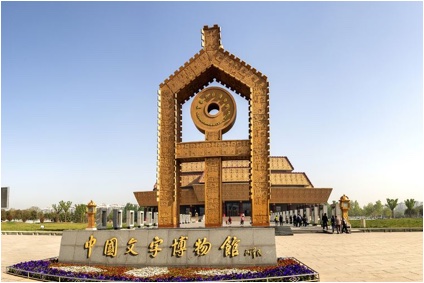South China becoming Chinese
« previous post | next post »
[This is a guest post by Bob Ramsey]
Museum of Chinese Writing near Anyang*, in North China:

*First stable capital of the Shang / Yin Dynasty (c.1600-1046 BC) and the site of the discovery of the largest cache of oracle bone inscriptions (beginning of the Chinese writing system).
In Confucius’s day, some 2,500 years ago, very few Chinese lived south of the Yangtze River. Most lived in the North, where Chinese culture and civilization had begun.
Back then, the southern part of what is now China belonged to other nationalities, which the Chinese referred to collectively as the Mán, or ‘Southern Barbarians.’ These non-Han people appeared strange and wild to the Chinese, and for Confucius and his contemporaries, the southeastern coast must have seemed as far away and exotic as California did to English settlers in Colonial America.
Nevertheless, Han Chinese naturally began to migrate into those southern territories, just as Americans did in the American West. As in America, a technologically superior people pioneered and colonized an enormous territory, overwhelming scattered and disparate native cultures in the process.
And yet, this Chinese incorporation of the South differed in crucial ways from the march of the white man across North America. For one thing, it took much longer. Whereas the American expansion took little more than a century, the Chinese movement south, by even the most conservative reckoning, took well over a millennium.
Even more important is what happened to native inhabitants. In the American West, there was little assimilation or intermarriage, and many indigenous groups disappeared without even a genetic trace. In China, by contrast, non-Han peoples and cultures were not so much erased as slowly absorbed.
Groups in South China in contact with Han immigrants gave up their original ways of life and became Chinese. They took up Chinese dress, customs, language. They gave up native names in favor of Chinese ones. And whereas white settlers in the American West lived in isolated communities, Han Chinese immigrants tended to settle in native villages and mingle with people already living there. Men married local women and brought up their children as Han Chinese. Even Han military colonies were not always segregated!
South China thus became Chinese gradually through the process of absorption, and the language and culture of the dominant people—the Han Chinese from the North—became the language and culture of all.
Selected readings
- "Taishan and Chinatown" (2/5/22)
- "Naxi writing" (1/24/22)
- "Miao / Hmong" (1/13/22)
- "The cattle-keeping Bai of Yunnan" (1/18/22)
- "A hidden minority revealed" (1/29/22)
Jenny Chu said,
February 15, 2022 @ 1:58 am
English was enriched by the borrowing (albeit often mangling) of words from Native American languages (raccoon, hickory), and especially place names (Massachusetts, Connecticut, Dakota). Did Chinese borrow any words from (say) Naxi or Miao/Hmong or Zhuang?
Tom Dawkes said,
February 15, 2022 @ 3:10 am
By a happy chance I found in 1995 in a provincial English secondhand book a copy of Edward H Schafer’s "The vermilion bird", which deals with the T’ang view of the south. I have dipped into it regularly.
Axel Schuessler said,
February 15, 2022 @ 6:13 am
To Jenny Chu’s question:
Yes, they did
Nick Kaldis said,
February 15, 2022 @ 9:25 am
What happened to the old Shang Dynasty dates of 1766-1122 BC? Are the new dates listed disputed?
Peter Erwin said,
February 15, 2022 @ 9:35 am
Somewhat related to Jenny Chu's question: Dan Jurafsky, in an excerpt from his book The Language of Food, discusses the origin of ketchup in Southeast Asian fish sauces, , and quotes from a 6th Century Chinese legend of how a conquering Han dynasty emperor acquired the secret of fermented fish paste from the I barbarians. ("This sauce then became known as Chu I to commemorate the fact that it was obtained while chasing the I barbarian[s].")
Since Jurafsky also mentions references to fermented sauces in poetry from before 300 BC, the quoted legend might not be accurate, but it does suggest that people in 6th Century China at least had an awareness of "we got some items of our culture by conquering barbarians"….
Scott P. said,
February 15, 2022 @ 2:12 pm
What happened to the old Shang Dynasty dates of 1766-1122 BC? Are the new dates listed disputed? There has been a broad and ongoing effort to improve our dating based on archaeology as well as the traditional texts.
https://en.wikipedia.org/wiki/Xia%E2%80%93Shang%E2%80%93Zhou_Chronology_Project
Jenny Chu said,
February 16, 2022 @ 7:42 am
@Axel Schuessler – I'd love to know some examples
Johannes Pong said,
February 17, 2022 @ 2:52 am
The simple word for the common chicken, which is known to have been domesticated from the SE Asian jungle fowl (compare gai from Thai), elephant (chang in thai), a lot of citrus fruit names (as citrus originated in South China), coconut (dừa in Vietnamese; pronounced "yua"), & probably a lot of plant, animal & place names, even the now common name for river 江, from a specific Southern river (khlong in Thai; Mekong is Mae Khlong, meaning "Mother River"). Even tech terms like 弩 "crossbow" was from Viet/ Thai, ultimately deriving from Sanskrit as the weapon went to South China/ SE Asia first from the Indian subcontinent.
Of course, a lot of random verbs and nouns in modern Cantonese, Min, Wu & Gan languages probably came from those Austroasiatic & Austronesian languages.
Some examples in Cantonese:
「蠄蟧」(蜘蛛) "spider"
「痕」(癢) "itch(y)"
「爾、邇」"this/here" (Thai & Viet [ni])